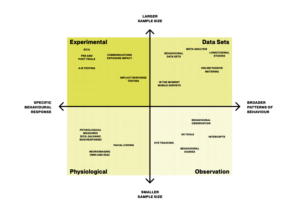By Lindsey Horne
Selecting the right approach for researching and exploring human behaviour can be a challenge. Behavioural insight practitioners and organisations looking to undertake behaviour change research have many different methodologies at their disposal to help them unlock behavioural insights, ranging from observational approaches to randomised control trials. This article provides an overview of different applied behavioural science methodologies and offers some simple steps toward selecting the most suitable approach to gain behavioural insights.
Self-Reported Behaviour Is Not Always Accurate
Despite our best intentions, the human mind is often unable to provide an accurate report of past behaviour or predict future behaviour. We are affected by cognitive biases that distort our memory and interpretation of what has happened and expectation of what is to come. When research data relies on asking people what actions they have taken or will be taking, this can be a problem.
Firstly, our memories are not reliable – especially when we are tired or under time pressure – and, because of cognitive biases such as the peak-end rule, some aspects of an event are more memorable to us than others. Secondly, we are also influenced by researcher and research effects, whether that’s interviewer bias or the Hawthorne Effect whereby people behave differently when they know they are the subject of research. Research participants also often want to provide socially desirable answers, skewing responses towards what they think is socially acceptable. Lastly, people can be overly optimistic about outcomes and overstate their abilities as well as those of their in-groups. When it comes to predicting behaviour, the value-action gap suggests that people’s intentions, attitudes and beliefs do not always correlate with their behaviours.
Behavioural Science Methodologies to Capture and Understand Real-World Behaviour
The biases associated with reporting behaviour illustrate the importance of exploring behaviour in the context in which it occurs. As people are affected various biases, their surroundings, as well as other situational factors, we cannot be confident in our findings if the research relies on self-reporting or took place in a setting that was too dissimilar from the real-world context. Applied behavioural science offers us many different research techniques and methods, but we must prioritise the environment and setting in which the behaviour is happening when considering what methodologies to use. If we’re exploring how people make lunch decisions in a cafeteria, for example, then the research should ideally happen in the cafeteria itself.
Selecting the Right Approach for the Job
First, be clear on the intention of the research and its objectives. Determine the stage of the research journey – is the behavioural research at the early, exploration phase where one needs to formulate hypotheses and gain contextual understanding? Or is the behavioural challenge well understood and the research looking to test and validate behavioural interventions?
Next, consider if the research is looking to understand a broad or specific pattern of behaviour. In the context of understanding people’s cyber security behaviours, for example, a broad pattern of behaviour would be to explore their current motivations for being secure online. A more specific behavioural response, however, would be testing how different behaviourally informed messaging impacts people’s motivation to update their password.
Finally, consider the sample size. Does the research approach allow for and/or require a large or more quantitative sample or a smaller, more qualitative sample? A smaller sample size is usually adequate for qualitative research that generates in-depth understanding and contextual insights. It’s also helpful for tracking a full end-to-end experience over time. A larger sample, on the other hand, has greater statistical power for quantitative research and may help us detect more meaningful differences and relationships between variables. Depending on the breadth of research and the sample size, we now have some more defined methodologies to consider.

Decoding Human Behaviour, Finalist in Habit Weekly’s Best Resource 2023.
Behavioural Observation
Behavioural observation is a great way to study behaviours in the contexts and environments in which they occur. It tends to be used to generate qualitative data and is well suited for investigating broader patterns of behaviour with smaller sample sizes. The methodology can include behavioural observation, intercept interviews, behavioural diaries or recruiting respondents to go on a behavioural mission. To capture the behaviour of these missions, eye tracking glasses and observation or video recording are helpful. For online behaviours, UX tools like mouse tracking or desktop eye tracking can be used.
An example of effective behavioural observation is using eye tracking glasses to understand how people navigate through a train station and make a transfer to other forms of public transport.
Secondary Behavioural Data Sets
Existing behavioural data sets are well suited to understanding broader patterns of behaviour. This includes data sets such as census data, engagement metrics, purchase and spend data, travel data or CRM data. Often, these data sets capture real world behaviour rather than experimental data and can be used to explore patterns or test hypotheses. In-the-moment mobile surveying is another way to capture real-world behaviour across a large sample.
An example of utilising these data sets is analysing traffic data, location tracking data and or public transport (looking at where people tagged on/off during a trip) to understand common trips and destinations and broader travel behaviour.
Experimental Methodologies
Experimental research helps us understand the impact of different variables, such as behavioural interventions, on a behavioural outcome. Randomised control trials or A/B testing have been called the ‘gold standard’ of applied behavioural research due to their ability to help us understand cause and effect relationships. This methodology works best with a larger sample size and more specific behaviours. Another experimental approach is implicit response testing, for example. This measures unconscious or automatic reactions to stimuli, which can gauge preferences over which people are not thought to have explicit awareness or conscious control.
An example of A/B testing is observing the effectiveness of a social norm message or subject line compared to a message with a loss frame or subject line in an email campaign – and then comparing the open rates of the two.
Amplifying Traditional Qualitative and Quantitative Techniques
Applying a behavioural science lens to standard quantitative and qualitative research techniques can help uncover actual behaviour vs self-reports. Some examples of this include:
- Grounding questions in the last behaviour people did rather than generalising behaviours
- In-the-moment mobile surveying to capture people’s behaviour at a given point in time
- Behavioural pre or post tasks – asking respondents to document a behaviour before or after an interview or focus group
- Behavioural observation and intercepts alongside qualitative interviews
In conclusion, behavioural science provides us with the tools to explore the complexities of human behaviour – helping us look beyond self-reported accounts which are often affected by biases. By knowing the context and environment in which the behaviour occurs, considering the breadth versus specificity of the behaviour in question and tailoring methodologies to sample sizes, we can pick the right tool for the job. Whether it be behavioural observation, analyzing larger data sets, experimental research or adapting more traditional research techniques, applying behavioural science methodologies can get us closer to generating robust behavioural insights.
This article was edited by Alain Samson.


